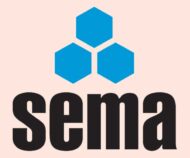Our first question this month asks about Fixing Beams and the second is asking about Racking Spacers.
 Fixing Beams
Fixing Beams
Q. We have two companies who are asking us to fix beams on site with nuts & bolts to prevent beam dislodgment as a permanent fix instead of using manufacturers beam clips.
Their argument is that beam clips can be removed or dislodged easily and therefore pose a risk.
SEMA training that I have had says that only manufacturers safety clips should be used and beams should not be bolted on standard APR.
Can you please refer me to the SEMA code of practice which states that bolts should not be used or clarify SEMA’s position?
More and more of the larger companies are sending staff on SEMA courses and mixed messages seem to be getting picked up.
A. The SEMA code of practice for the use of static pallet racking recommends that any missing locking devices should be replaced immediately to prevent accidental dislodging of the beams and that a supply of beam locking devices is held on site.
EN15635 states that “beams shall be locked in position as prescribed by the rack supplier”.
SEMA recommends using only the manufacturers approved locks as the strength of nuts and bolts is not known. Some may be weaker than required whereas some may be stronger. If a nut and bolt is used the bolt may have a greater shear value than the ½ tonne mentioned and in addition will restrain the connector close to the upright so the connector will be wedged into the slots of the upright. Most trucks will lift well over the ½ tonne design force and eventually will tear the connector away from the upright causing substantial damage to the upright in the process. This can often reduce the remaining upright section to the level that it cannot carry the imposed load and so also collapses.
Sometimes a nut and bolt fix is used as a cure for a symptom, without addressing the underlying cause, which might be poor driving techniques, or lack of clearances causing repeated impacts of a back beam etc.
SEMA would recommend that an experienced engineer, possibly from the rack manufacturer, be requested to look at the problem. They should be able to make some specific recommendations in this area.
Racking Spacer Requirement
Q. Hi, I would be grateful if you could confirm or advise me on the following: I have been told by a racking company that I need to fit spacers to connect my free standing racking together. They are telling me this is a legal requirement. I have 6 racks in total creating 3 aisles. Dimensions of the racks area as follows: Depth -1.1m , Height- 6m and length- 28m. Space between back to back racks is 300mm.
Reading through the SEMA Code for design of static racking ,clause 8.2.2 states that racks more than 10 to 1 height depth ratio require spacers. Can you confirm that based on the dimensions of my racking that I do not need to fit the racking spacers. I do understand it is good practice but we firstly need to know if its mandatory to do so. Your help in this matter is greatly appreciated?
A. Unless the racking is part of a building it is not covered by specific legally binding codes. If the racking is part of a building then the Building Regulations are relevant.
However, racking is work equipment and must therefore, be correctly designed, used, inspected and maintained. This is normally achieved by compliance with various codes and other guidance documents.
You are already aware of the guidance given in the SEMA design code however, you might not be aware of HSG76 “Warehousing and Storage. A guide to health and safety” published by HSE. This is available as a free download at www.hse.gov.uk/pubns/books/hsg76.htm.
Paragraph 634 of HSG76 states that “Double-sided runs should be connected and spaced using suitable run spacers”. In the event that run spacers are fitted they should be provided as recommended in the SEMA Code for the design of static racking.
HSG76 includes the following statement “Following the guidance is not compulsory and you are free to take other action. But if you do follow the guidance you will normally be doing enough to comply with the law.
Health and safety inspectors seek to secure compliance with the law and may refer to this guidance as illustrating good practice”. So, HSG76 is not a legal requirement and its recommendations are not mandatory however, it is a guide intended as an aid to health and safety management and has a level of authority.
The 2021 SEMA Safety Conference has been scheduled for Thursday, 4 November; at the National Motorcycle Museum, Solihull. For full details email enquiry@sema.org.uk
SEMA runs a one-day safety course on Rack Safety Awareness and Inspection, aimed at end users, giving an in-depth look at the need for inspections, how to conduct an assessment and what actions to take when this is completed.
SEMA Approved Rack Inspectors Qualification is aimed at professionals who conduct rack surveys as an integral and significant part of their duties. It involves delegates in undertaking an in-depth SEMA Course, together with an examination and practical assessment.
SEMA has 26 publications in stock – Codes of Practice, ‘Guides’ and European documents. For further information visit www.sema.org.uk. and click on ‘Codes of Practice’.
SEMA runs a USERS Club designed to be of benefit to purchasers and users of storage equipment. Members receive newsletters, access to specialised events and discounted rates on publications and codes of practice.
SEMA




Comments are closed.